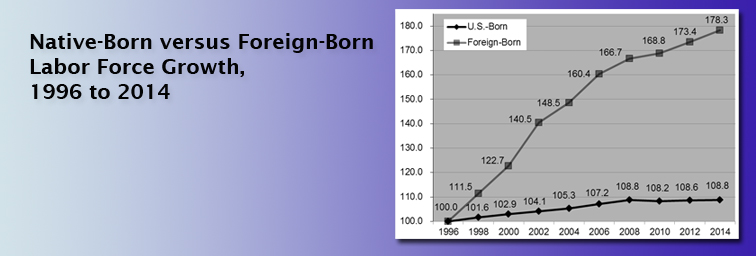
The Negative Economic Impact of Immigration on American Workers
- Edwin S. Rubenstein
- March 8, 2016
- Forum Papers
- Forum Paper
- 0 Comments
![]() Your gift helps publish and distribute materials like this.
Your gift helps publish and distribute materials like this.
Click here for a downloadable, printable PDF version
The Negative Economic Impact of Immigration on American Workers
by Edwin S. Rubenstein
We are a nation of immigrants: except for American Indians, we or our ancestors left other countries for a better life in the United States.
For much of our history, immigration was good for the economy. Compared to Europe, the U.S. was well endowed with land and capital but relatively short of labor. By populating the frontier, increasing the size of the market economy, and adding valuable skills and expertise to the native workforce, successive waves of foreign workers enhanced the living standards of earlier immigrants as well as their U.S.-born children.
In economic terms, immigration was a win-win proposition — benefiting immigrants as well as natives. Our immigration policy reflected this: from the founding of the republic until the 1920s, there were no quantitative limits on immigration. Federal, state, and local governments, private employers, railroads, and churches all promoted immigration to the United States. Early infrastructure projects — canals and railroads, for example — recruited immigrant workers. In those pre-globalization days high tariffs kept out imports, thus creating a demand for more workers in American factories. Even the army relied on immigrants — immigrants were about a third of the regular soldiers in the 1840s, and an even higher proportion of many state militias.
Eventually the frontier vanished, and American cities became overcrowded. Our physical capacity to absorb new arrivals eroded. While America’s industrial economy boomed, millions of the new jobs went to immigrants who poured into the country between 1890 and 1920. These men and women enriched our culture, but they also moved ahead of — and often displaced — native-born workers.
Immigration became a zero-sum game: the economic gains accruing to immigrants were more than offset by losses suffered by natives.
In 1921, Congress responded with the first quantitative restrictions on immigration — limiting arrivals to 3% of the foreign-born population. In 1924 immigration was cut again, to 160,000 a year. By the late 1920s, it was down to 50,000 a year.
The American Federation of Labor’s Samuel Gompers, himself an immigrant, saw restrictionist legislation as a necessary antidote to the 1890–1920 Great Wave. “We immediately realized that immigration is, in its fundamental aspects, a labor problem,” Gompers said in 19252.
Jay Gatsby notwithstanding, the Roaring Twenties marked the start of a forty-year period during which ordinary workers got richer while the rich got relatively poorer. After an early recession, unemployment dropped below 5% and stayed below that level for most of the decade. Americans found themselves sharing broadly similar lifestyles in a way not seen since before the Civil War.
Amazingly, only about 500,000 legal immigrants entered the U.S. during the whole of the 1930s. And only about a million entered in the 1940s — including World War II refugees. The post-war era saw a return to the 156,700 per year cap on legal immigration.
Immigration restrictions remained the law of the land for more than forty years. That era ended in 1965.
Ed Rubenstein, president of ESR Research, is an experienced business researcher, financial analyst, and economics journalist. He has written extensively on federal tax policy, government waste, the Reagan legacy, and – most recently – on immigration. He is the author of two books: The Right Data (1994) and From the Empire State to the Vampire State: New York in a Downward Transition (with Herbert London). His essays on public policy have appeared in The Wall Street Journal, The New York Times, Harvard Business Review, Investor’s Business Daily, Newsday, and National Review. His TV appearances include Firing Line, Bill Moyers, McNeil-Lehr, CNBC, and Debates-Debates. Mr. Rubenstein has a B.A. from Johns Hopkins and a graduate degree in economics from Columbia University.
